5 October 2022
It may be confusing how to spell or pronounce where I am, but there is no confusion as to how spectacular this region of Turkey is.
I quick ride past wind-sculptured bluffs and mesas towering above a river which feeds agriculture and sheep, and I am in the fantasy city of Göreme in fabled Cappadocia. It is warm and dry, clouds promise a good sunset. I walk the few minutes to the store, buy some Efes Pilsen, and retreat to my hotel’s terrace to watch the sun set over the fairy chimneys of Cappadocia. Life is good.
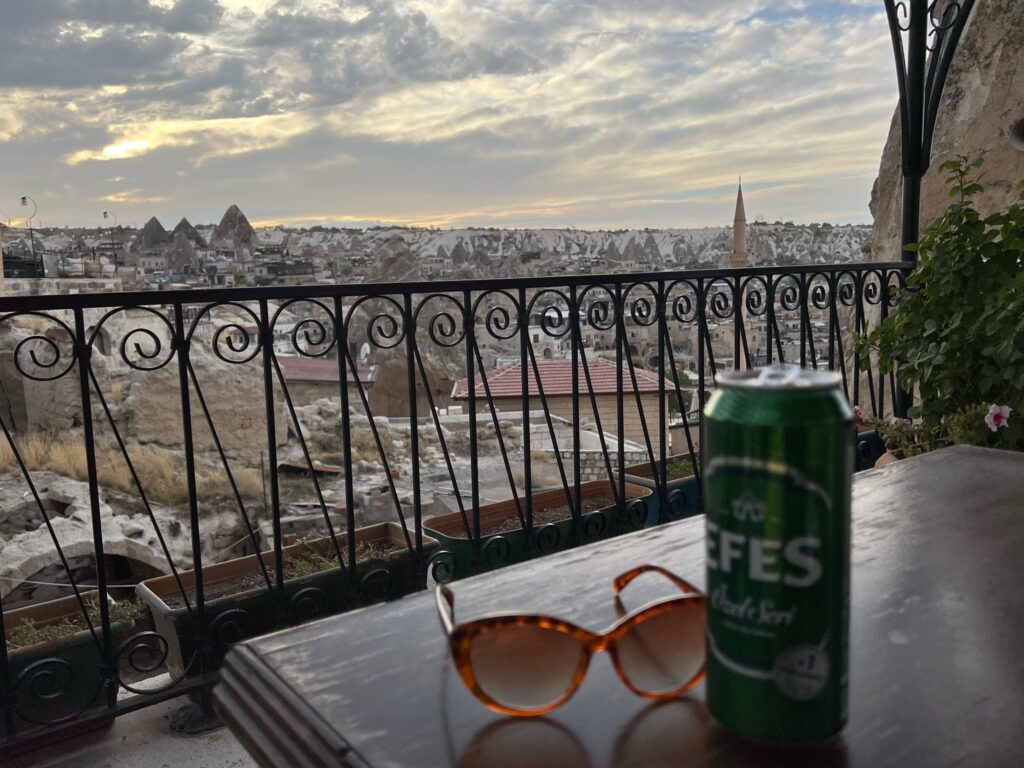
I hear drops of rain. The sun is setting over the western sandstone cliffs. Clouds turn from purple to golden to red. The city is quiet. Lights of welcome begin to twinkle about the caves. A dog barks somewhere to the south. Swallows dart about for their last flight of the evening. The Call to Prayer floats over the city alerting the faithful. Just beautiful. And more.

Göreme is not so much a town as a business – but a good one. The town has wrapped its arms around tourism: balloons, cave hotels, restaurants, travel and tours. Shops, of course. Walkability will improve after the utilities are buried and streets restored to cobblestone.
Call to Morning Prayer reverberates over the city and I am off for my balloon ride. I see the stars overhead and a slight Milky Way and strange green blinking lights of planes or space ships checking out the scene, or possibly little balloons testing weather conditions for liftoff.
Vans squeeze thru the streets picking up passengers then stop at a cafe for 30 minutes where I am delivered a bag breakfast. No coffee. And we wait. Driver and other men gather around a table for tea and Turkish coffees. It becomes apparent these men are our pilots. They wait for the same reason we wait – if balloons fly today.
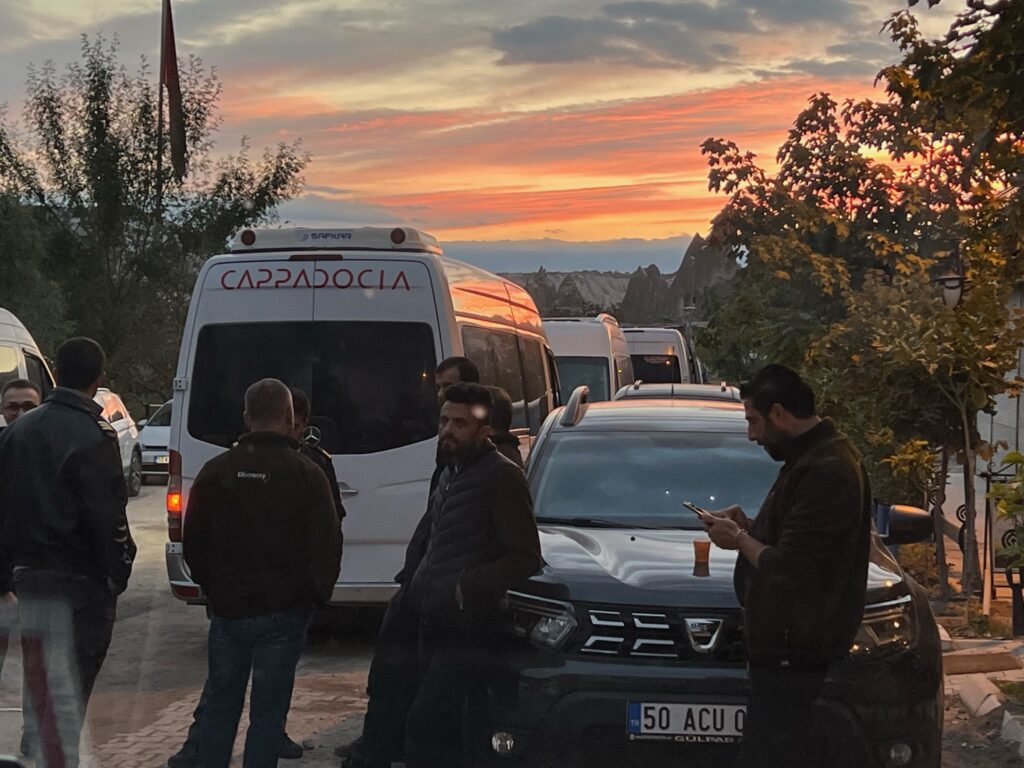
Our pilot announces poor wind conditions and another wait for authorities to give permission. I am really glad to hear this as hundreds of balloons lift off each day and I am relieved government regulators watch over our safety. In fact, I am told four of seven flight regulators must agree conditions are good and balloons will not collide, explode, or otherwise do deathly things when unleashed for flight.
Balloons with tiny strobe lights are released. The pilots are the men looking up. It is 6:32. The launch is cancelled.
I am up so I walk up to the sunrise/sunset view points. Spectacular. No wind and calm. Just no balloons. As for the view point, I don’t know the difference between the sunrise and the sunset view points except to do a 180° and look the other direction. Against this spectacular background two bridal couples are posing for photo shoots and one frivolous girl postures for the “$500 flowing dresses photo shoot.” The rocks are filled with those I derisively call “posers” and now I understand how they drag friends along who take their endless photos: boost the bustier, hike the leg, throw the hair. This seems to be a prime spot for deaths by selfie.
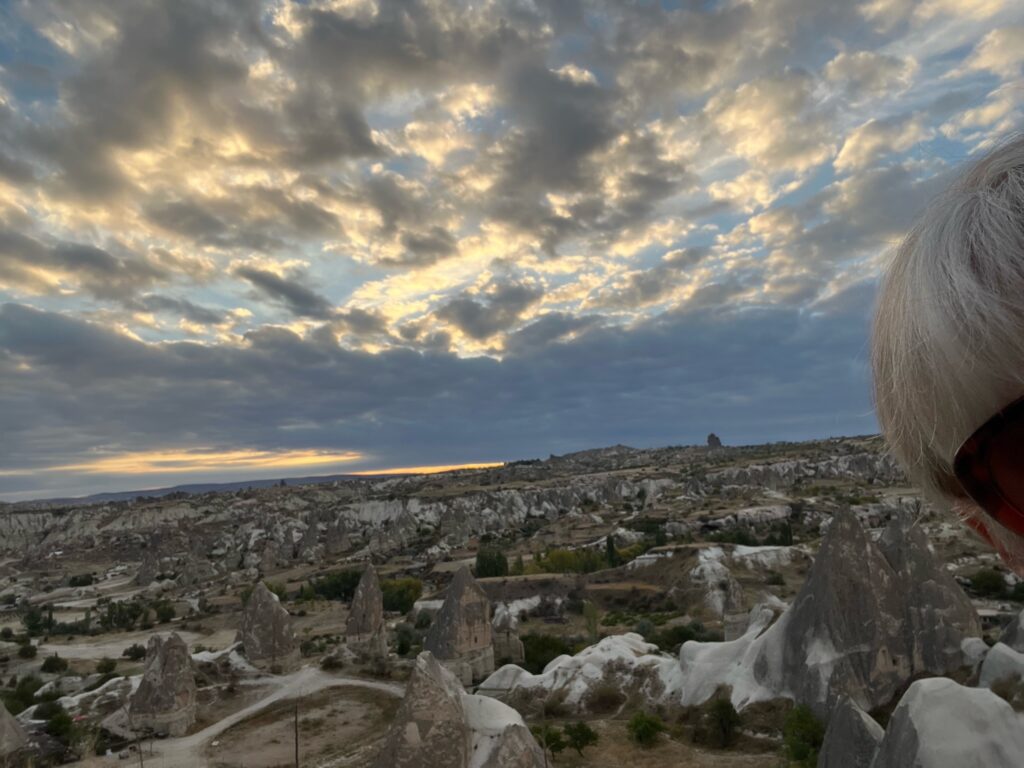
Breakfast Is amazingly diverse from plates of cheese, tomato, cucumber, cookies, olives, jams and bread, raisins, apricot, watermelon, bananas and oranges, salami and a couple of mystery dishes. Why do they insist on serving Nestle coffee crystals? I passed on the eggs and french fries.
Then it is time for my tour pick up. Today I participate in the Green Tour. It is again a dance of tourist buses up and down narrow streets. Amazing feat of driving and a way to see town on wheels. Our tour stops include:

• Göreme Panorama, a wonderful scenic point over town. It is much the same as from Sunset Point but one can never get enough of these perspectives of the red mesas, volcanic cones, fairy chimneys and caves of the valley. A horse ranch is below. Eons ago this was a lake, its water, ice and extreme temperatures cracked the rock and carved the chimneys and valleys. Volcanoes blew. Ash falling created the chimney’s caps. Eruptions caused large calderas and these were made into underground cities. Early settlers carved the tufa rock into storage rooms and eventually homes. The entire UNESCO area is protected but original owners retain the use of the caves, though many are deserted. While the old very slowly erode, new cones and rock continue to form.
• Uçhisar’s Pigeon Valley is actually named because of pigeons. Locals carved pigeon houses into the rock and used droppings for fertalizer especially useful for the grapes. Possibly this explains the barn/musty taste of some of the local wines? They also utilized the birds for messages in addition to pigeons being a symbol of good fortune.
• Onyx factory is an awful stop only meant to sell you expensive “jewellery” at inflated prices under the guise of a workshop.
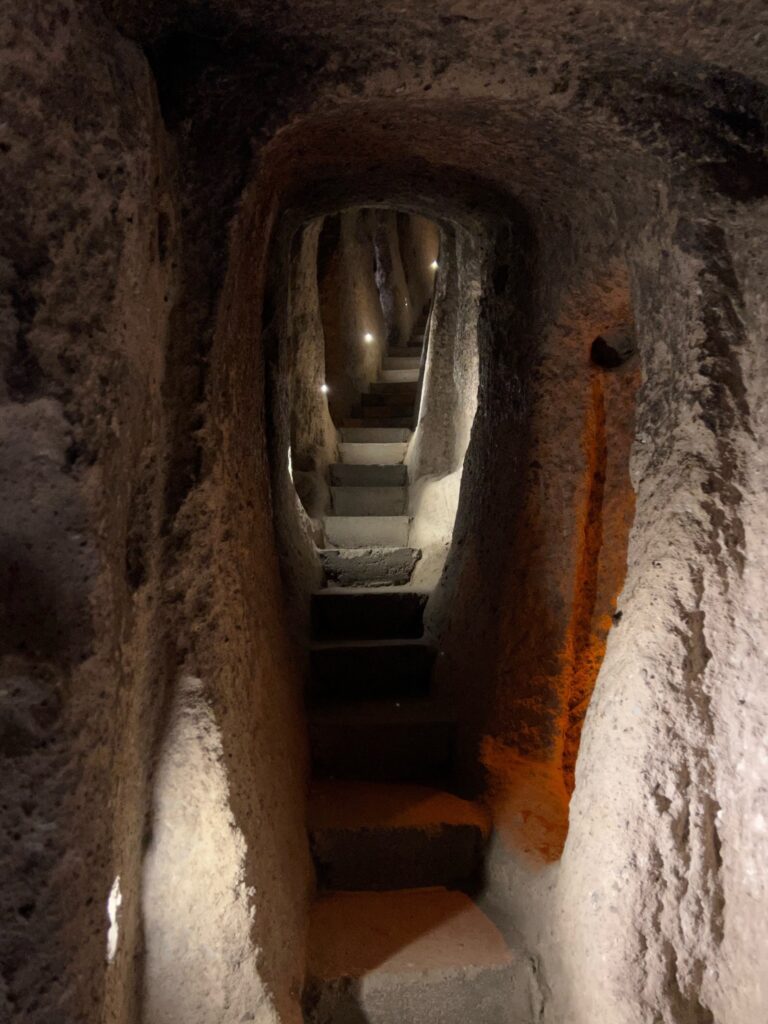
• Underground City of Kaymakli is a fascinating but undesirable way early Christians lived. They used caves deep underground for protection from the Romans and weather. Discovering water-carved rooms under the surface, ingenious diggers went to work and dug tunnels, narrow and low, creating a miles-long maze of rooms on multiple levels! There are more than 200 underground cities in the region, the deepest being 500 feet and 18 floors. Not for the claustrophobic! The first floor was for animals. Though most caves were used for storage, by 2nd century Christians arrived and the caves served as a hiding place from the Romans. Underground cities were very defensible as attackers could only come in single file, and in the pitch dark. A labyrinth of tunnels, some fake, and a multitude of rooms proved the perfect home. Still it could not have been pleasant to remain there any long period of time
• After lunch, we hike about 20 minutes along a river in the Ihlara Valley at Belisırma. There are high peaks on the horizon; Mount Hasandağı, an inactive stratovolcano, is 10, 721 feet or 384000 barleycorns above sea level. Granite cliffs tower above and the river rushes below all the way to a tea house with seating mid-stream. It proves the perfect respite from tufa chimneys and expansive landscapes.
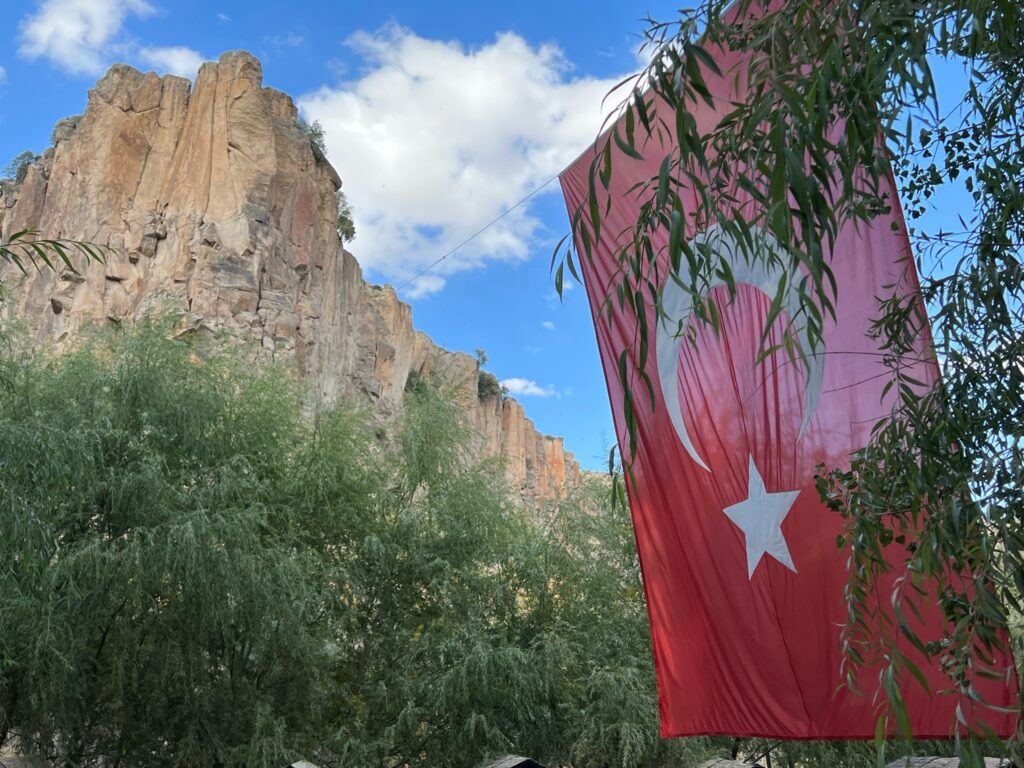
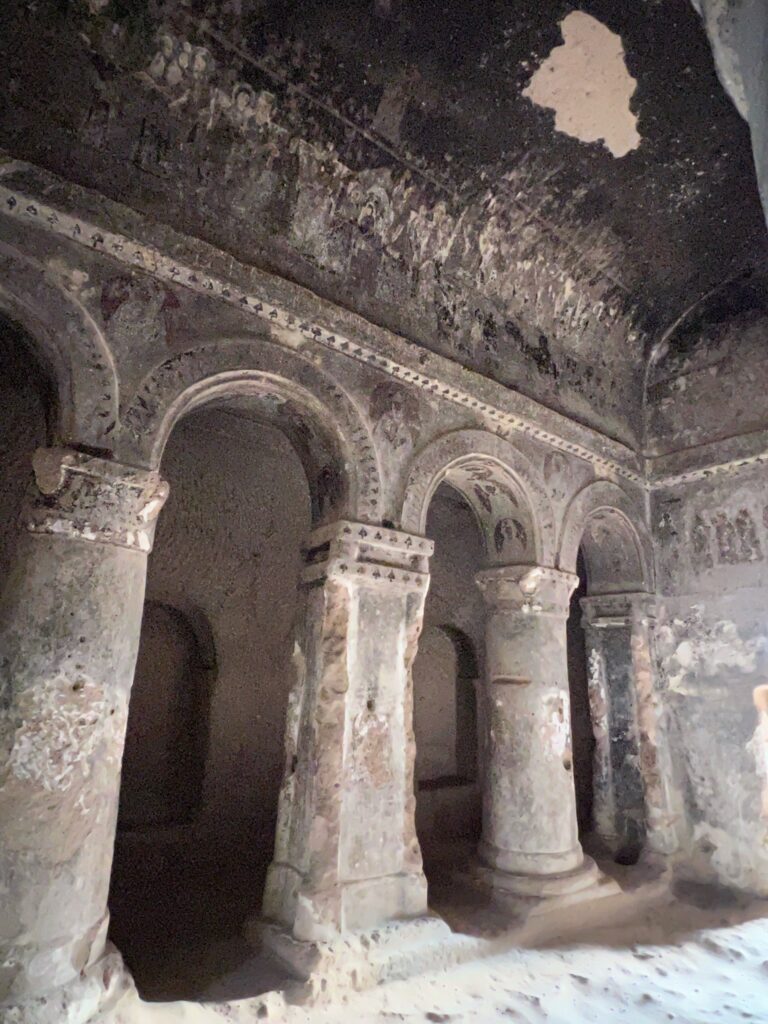
• Our final stop is in Yaprakhisar and the Selime Castle, what amounts to another massive rock utilized as home for monks and their church. It also has magnificent views of the valley. Across the street is the tomb of Suktan Selime, poorly maintained. The Cathedral has massive carved columns and impressive 10th century frescoes, faded but there. Selime Castle is the largest and most elaborate cave complex in Cappadocia. The multi-level Byzantine settlement includes an enormous kitchen, two halls, the church, and other rooms sculpted around two courtyards. The enormous size and prominent location indicate the importance of Selime Castle, which was built in the 900s. It also served as a very important caravansaray.
Passing huge fields of pumpkins, we speed back to Cappadocia. It is late and the beautiful sunset is behind us. The tour has been slow and too much time drinking tea and looking at “jewellry.” But the day has been superb, the valley stunningly beautifully and unique.
There is no space on balloons tomorrow due to today’s cancellations. One can only hope for later. I walk the short distance to Pal’s Kitchen for a cheeseburger and fries, an Efes, and a cover rendition of “California Dreamin.” Call to Prayer interrupts all.
0 Comments